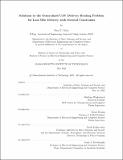Solutions to the Generalized UAV Delivery Routing Problem for Last-Mile Delivery with Societal Constraints
Author(s)
Gaba, Farri T.
DownloadThesis PDF (12.73Mb)
Advisor
Winkenbach, Matthias
Boning, Duane
Terms of use
Metadata
Show full item recordAbstract
Unmanned aerial vehicles (UAVs) are becoming an increasingly popular transporta- tion modality to improve efficiency, cut costs and increase customer service levels amongst last-mile industry players and academics alike. UAV operations planning is uniquely challenging because of UAV capacity and range constraints, the host of aeronautic regulation UAVs are subject to, and the significant externalities it imparts on the communities that they operate amongst that could materialize into additional operational restrictions. Previous research contributions have focused on the vehicle routing, environmental life-cycle analysis, economics and policy implications of un- manned aerial vehicles for last-mile delivery (UAV-LMD), typically in isolation.
This thesis complements previous efforts by adopting an inter-disciplinary perspective of anticipated UAV-LMD operations. It first performs a survey of the most significant societal and regulatory barriers facing UAV-LMD today and in the coming decades and offers insight into potential regulatory pathways to constrain operations. Second, it extends existing UAV routing methodologies to capture these constraints and UAV-specific routing features in three competing routing models, offering a com- parative analysis of their performance and identifying performance advantages of a heuristics-based routing approach. Finally, this thesis performs a sensitivity analysis of societal and regulatory constraint intensity, technology progression and demand density on realistic demand instances. It finds that, independent of demand density, societal and regulatory constraint intensity as well as UAV technology progression lev- els drive UAV-LMD operational costs with the potential to render it uncompetitive compared to traditional fulfillment modalities.
Date issued
2022-05Department
Massachusetts Institute of Technology. Department of Electrical Engineering and Computer Science; Massachusetts Institute of Technology. Institute for Data, Systems, and SocietyPublisher
Massachusetts Institute of Technology